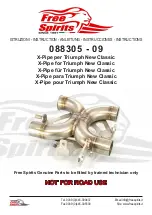
1-1
SERVICING A NEW MOTORCYCLE
1
WARNING
Always follow the listed service and maintenance
recommendations, since they affect the safe operation of
the motorcycle and the personal welfare of the rider.
Failure to follow recommendations may cause personal
injury.
Service operations to be performed before customer delivery
are specified in the applicable model year PREDELIVERY
AND SETUP MANUAL.
The performance of new motorcycle initial service is required
to keep warranty in force and to ensure proper emissions
systems operation.
After a new motorcycle has been driven its first 500 miles,
and again at 2500 mile intervals, a Buell dealer should
perform the service operations listed in the
chart on
.
SAFE OPERATING MAINTENANCE
A careful check of certain equipment is necessary after
periods of storage, and frequently between regular service
intervals, to determine if additional maintenance is required.
1
CAUTION
●
Do not attempt to retighten engine head bolts.
Retightening can cause engine damage.
●
During the initial 500 mile (800 km) break-in period,
use only 20W50 engine oil. Failure to use the
recommended oil will result in improper break-in of
the engine cylinders and piston rings.
●
Do not lubricate the enrichment cable on C.V.
carburetors. The cable requires friction to operate
properly.
Check:
1.
Tires for abrasions, cuts and correct pressure.
2.
Secondary drive belt for proper tension and condition.
3.
Brakes, steering and throttle for responsiveness.
4.
Brake fluid level and condition. Hydraulic lines and
fittings for leaks. Also, check brake pads and rotors for
wear.
5.
Cables for fraying, crimping and free operation.
6.
Engine oil and transmission fluid levels.
7.
Headlamp, passing lamp, tail lamp, brake lamp and turn
signal operation.
SHOP PRACTICES
Repair Notes
NOTE
●
General maintenance practices are given in this section.
●
Repair = Disassembly/Assembly.
●
Replace = Removal/Installation.
All special tools and torque values are noted at the point of
use.
All required parts or materials can be found in the appropriate
PARTS CATALOG.
Safety
Safety is always the most important consideration when
performing any job. Be sure you have a complete
understanding of the task to be performed. Use common
sense. Use the proper tools. Protect yourself and bystanders
with approved eye protection. Don’t just do the job – do the
job safely.
Removing Parts
Always consider the weight of a part when lifting. Use a hoist
whenever necessary. Do not lift heavy parts by hand. A hoist
and adjustable lifting beam or sling are needed to remove
some parts. The lengths of chains or cables from the hoist to
the part should be equal and parallel and should be
positioned directly over the center of the part. Be sure that no
obstructions will interfere with the lifting operation. Never
leave a part suspended in mid-air.
Always use blocking or proper stands to support the part that
has been hoisted. If a part cannot be removed, verify that all
bolts and attaching hardware have been removed. Check to
see if any parts are in the way of the part being removed.
When removing hoses, wiring or tubes, always tag each part
to ensure proper installation.
Cleaning
If you intend to reuse parts, follow good shop practice and
thoroughly clean the parts before assembly. Keep all dirt out
of parts; the unit will perform better and last longer. Seals,
filters and covers are used in this vehicle to keep out
environmental dirt and dust. These items must be kept in
good condition to ensure satisfactory operation.
Clean and inspect all parts as they are removed. Be sure all
holes and passages are clean and open. After cleaning,
cover all parts with clean lint-free cloth, paper or other
material. Be sure the part is clean when it is installed.
Always clean around lines or covers before they are removed.
Plug, tape or cap holes and openings to keep out dirt, dust
and debris.
GENERAL
1
Summary of Contents for S1 Lightning
Page 2: ...2 NOTES ...
Page 10: ...10 NOTES ...
Page 12: ...12 NOTES ...
Page 18: ...18 NOTES ...
Page 20: ...20 NOTES ...
Page 24: ...24 NOTES ...
Page 26: ...26 NOTES ...
Page 30: ...30 NOTES ...
Page 32: ...32 NOTES ...
Page 201: ...RETURN OIL FEED OIL RETURN OIL FEED OIL INTERNAL ENGINE PASSAGES ...
Page 362: ......
















































